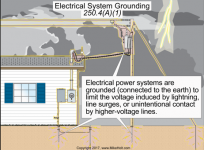- Location
- Bremerton, Washington
- Occupation
- Master Electrician
For the OPer, the reason why ground rods are not required with a Ufer is:
250.53 D 2 requires a supplemental electrode for a metal UG water pipe, of a type specified in 250.52A 2 thru A 8, IE metal structure, CEE, ground ring, rod, other listed, plate or other UG structures
The reason for this requirement is that metal UG water pipes (starting in the 1950s) were being replaced with plastic pipes
If you have a Ufer of CEE ground, then it does not need to be supplemented.
But if you install a rod, then it becomes part of the "grounding electrode system"
In ten years, our institutional knowledge and handed down electrical information will be gone. On the job it will be the
Old guy saying, back in the day we had to drive ground rods
New guy, whats a ground rod?
250.53 D 2 requires a supplemental electrode for a metal UG water pipe, of a type specified in 250.52A 2 thru A 8, IE metal structure, CEE, ground ring, rod, other listed, plate or other UG structures
The reason for this requirement is that metal UG water pipes (starting in the 1950s) were being replaced with plastic pipes
If you have a Ufer of CEE ground, then it does not need to be supplemented.
But if you install a rod, then it becomes part of the "grounding electrode system"
In ten years, our institutional knowledge and handed down electrical information will be gone. On the job it will be the
Old guy saying, back in the day we had to drive ground rods
New guy, whats a ground rod?


